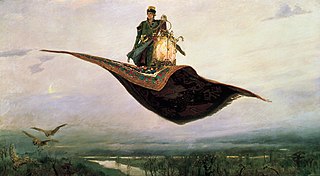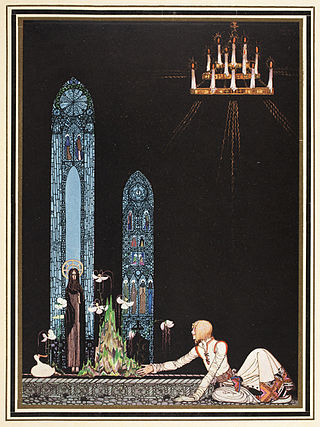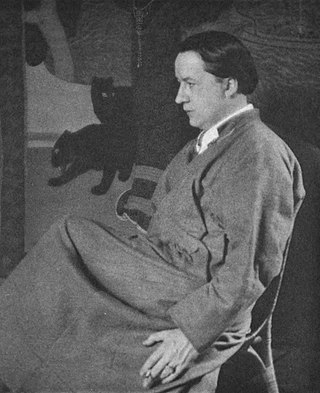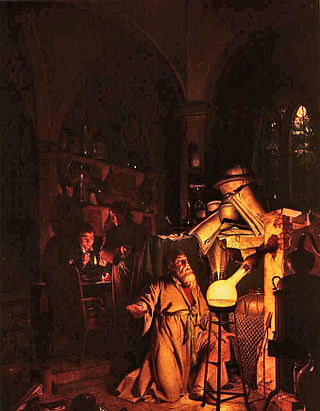
One Thousand and One Nights, is a collection of Middle Eastern folktales compiled in the Arabic language during the Islamic Golden Age. It is often known in English as the Arabian Nights, from the first English-language edition, which rendered the title as The Arabian Nights' Entertainment.

Nigel Tranter OBE was a writer of a wide range of books on history and architecture, both fiction and non-fiction. He was best-known for his popular and well-researched historical novels, covering centuries of Scottish history.

Aladdin is a Middle-Eastern folk tale. It is one of the best-known tales associated with One Thousand and One Nights, despite not being part of the original text; it was added by the Frenchman Antoine Galland, based on a folk tale that he heard from the Syrian storyteller Hanna Diyab.

Sinbad the Sailor is a fictional mariner and the hero of a story-cycle. He is described as hailing from Baghdad during the early Abbasid Caliphate. In the course of seven voyages throughout the seas east of Africa and south of Asia, he has fantastic adventures in magical realms, encountering monsters and witnessing supernatural phenomena.

A magic carpet, also called a flying carpet, is a legendary carpet and common trope in fantasy fiction. It is typically used as a form of transportation and can quickly or instantaneously carry its user(s) to their destination.

The Wishing-Chair is a series of two novels by the English author Enid Blyton, and a third book published in 2000 compiled from Blyton's short stories. The three children's stories are as follows:
This is a list of the books written by G. K. Chesterton.

Kay Rasmus Nielsen was a Danish illustrator who was popular in the early 20th century, the Golden Age of Illustration which lasted from when Daniel Vierge and other pioneers developed printing technology to the point that drawings and paintings could be reproduced with reasonable facility. Nielsen is also known for his collaborations with Disney for whom he contributed many story sketches and illustrations, not least for Fantasia.

Edmund Dulac was a French-British naturalised magazine illustrator, book illustrator and stamp designer. Born in Toulouse, he studied law but later turned to the study of art at the École des Beaux-Arts. He moved to London early in the 20th century and in 1905 received his first commission to illustrate the novels of the Brontë Sisters. During World War I, Dulac produced relief books. After the war, the deluxe children's book market shrank, and he then turned to magazine illustrations among other ventures. He designed banknotes during World War II and postage stamps, most notably those that heralded the beginning of Queen Elizabeth II's reign.
Hodder & Stoughton is a British publishing house, now an imprint of Hachette.

A magic ring is a mythical, folkloric or fictional piece of jewelry, usually a finger ring, that is purported to have supernatural properties or powers. It appears frequently in fantasy and fairy tales. Magic rings are found in the folklore of every country where rings are worn. Some magic rings can endow the wearer with a variety of abilities including invisibility and immortality. Others can grant wishes or spells such as neverending love and happiness. Sometimes, magic rings can be cursed, as in the mythical ring that was recovered by Sigurð from the hoard of the worm Fáfnir in Norse mythology or the fictional ring that features in The Lord of the Rings. More often, however, they are featured as forces for good, or as a neutral tool whose ethical status in the narrative derives from the character that uses it.

Victor Rousseau Emanuel was a British writer who wrote novels, newspaper series, science fiction and pulp fiction works. He was active in Great Britain and the United States during the first half of the 20th century.

Fables: 1001 Nights of Snowfall is a graphic novel prequel to the comic book series Fables written by series creator Bill Willingham with a variety of artists. It was released on October 18, 2006 by Vertigo.

Patricia Holm is the name of a fictional character who appeared in the novels and short stories of Leslie Charteris between 1928 and 1948. She was the on-again, off-again girlfriend and partner of Simon Templar, alias "The Saint", and shared a number of his adventures. In addition, by the mid-1930s, Holm and Templar shared the same flat in London, although they were unmarried. Although such co-habitation between unmarried partners is commonplace today, it was rare, shocking in the 1930s. The two also appeared to have a somewhat "open" relationship, with Holm accepting Templar's occasional dalliances with other women.

Claud Eustace Teal is a fictional character who made many appearances in a series of novels, novellas and short stories by Leslie Charteris featuring The Saint, starting in 1929. A common spelling variation of his first name in reference works and websites is Claude, however in his works Charteris uses the spelling without the 'e'.

Elements of the supernatural and the fantastic were an element of literature from its beginning, though the idea of a distinct genre, in the modern sense, is less than two centuries old.
Anna Masterton Buchan was a Scottish novelist who wrote under the pen name O. Douglas. Most of her novels were written and set between the wars and portrayed small town or village life in southern Scotland, reflecting her own life.

Doraemon: Nobita's Dorabian Nights, also known as Doraemon Nights, is a 1991 Japanese animated science fantasy film which premiered on 9 March 1991 in Japan, based on the 11th volume of the same name of the Doraemon Long Stories series. It's the 12th Doraemon film.

The story of Little Muck is a fairy tale written by Wilhelm Hauff. It was published in 1826 in a collection of fairy tales and tells the story of an outsider called Little Muck.
















